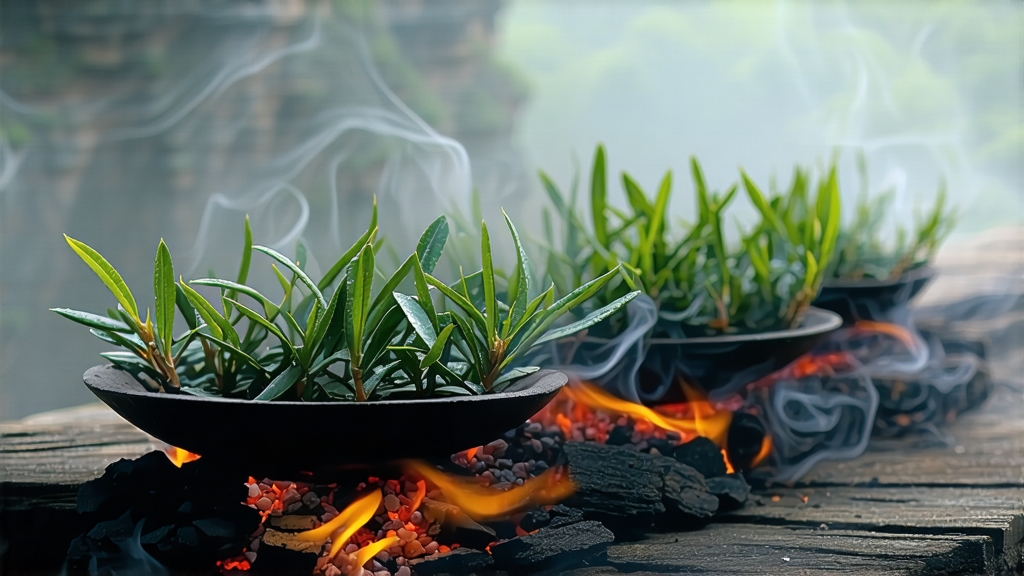
When most people hear “black tea” they picture a dark, malty cup from Assam or Ceylon, yet the very word “black” was first applied to a small, twisted leaf from the granite gorges of northern Fujian. Lapsang Souchong—literally “small-sort pine-village tea”—is the primordial black tea, the style that launched the genre in the early seventeenth century and, via Dutch and British merchants, re-defined breakfast tables from Amsterdam to Boston. To understand it is to hold a living fossil that still breathes campfire perfume into the twenty-first century.
Origin & Myth
The Wuyi massif, a UNESCO dual heritage site, rises like a petrified wave above the Min River. Its narrow, mist-locked valleys create a unique micro-climate: 85 % humidity, temperature swings of 15 °C between day and night, and acidic, mineral-laden lateritic soil. Local legend credits the birth of black tea to a passing Qing-era army that commandeered a tea hamlet near Tongmu Guan. To dry the leaf quickly before the soldiers returned, farmers spread it over pine fires; the smoke impregnated the leaf, and the coppery liquor that emerged was deemed delicious. Commerce soon replaced contingency: by 1604 the Dutch East India Company listed “bohea” (the Min-dialect pronunciation of Wuyi) at twice the price of green tea in Amsterdam auctions.
Two Families, One Mountain
Today the name Lapsang Souchong covers two distinct families. The traditional, smoke-dried version (zhengshan xiaozhong) is produced only inside the 600 km² core Wuyi reserve; leaf from outside, even if processed identically, may be sold as “wai shan” or simply “black tea.” Since 2005 a new, un-smoked style called “no-smoke xiaozhong” has emerged to suit modern palates, but connoisseurs still revere the pine-smoked original as the benchmark. Within the reserve, micro-terroirs such as Guanping, Mawei, and Miaowan yield subtle differences: Guanping leaf carries higher geraniol, giving lychee-like top notes, while Miaowan’s slower withering builds deeper dried-longan sweetness.
From Leaf to Log-fire
The harvest begins around Qingming when the first two leaves and a bud reach 3–4 cm. Pickers pluck only between 9 a.m. and 3 p.m. to avoid overnight dew; the leaf is then carried in shallow bamboo baskets to prevent compression. Once in the factory, the craft follows five immutable steps:
- Withering: 8–10 h on bamboo racks set 1.5 m above smouldering pine embers (Pinus massoniana). Temperature is kept at 30 °C; artisans judge readiness when a handful crackles without breaking.
- Rolling: 60 min on cast-iron plates rotating at 28 rpm. The goal is 90 % cell rupture to liberate polyphenol oxidase.
- Oxidation: Leaf is piled 8 cm deep in cedar boxes for 3 h at 26 °C and 85 % RH. The colour shifts from jade to copper, and a malty aroma reminiscent of rye bread emerges.
- Smoking & Firing: The critical dual-stage that defines Lapsang. A pine-log pit is heated to 80 °C; workers spread the oxidised leaf on sieves 70 cm above the fire for 2 min, then turn off the heat and allow 30 min of absorption. This cycle repeats six times, consuming 1 kg of pine for every kg of finished tea. Finally the leaf is baked at 100 °C to drop moisture to 3 %.
- Sorting: Charcoal-black flakes are sifted through ten mesh sizes; only the top three grades—souchong (≤0.4 cm), broken souchong, and broken orange pekoe—earn the zhengshan seal.
Chemistry in a Cup
Gas-chromatography reveals the signature molecules: guaiacol (smoke), eugenol (clove), longifolene (pine), and a rare β-ocimene that imparts a hint of mango. Despite the robust nose, the liquor is surprisingly soft: 0.8 % tannins versus 1.4 % in